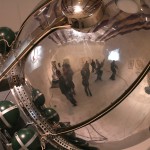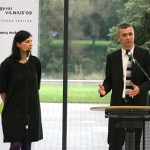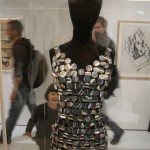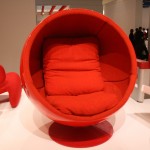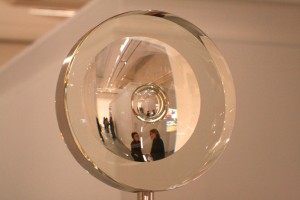
"Glass Object" a concave decoration by Czechoslovak artist Václav Cigler. Photo by Nathan Greenhalgh.
VILNIUS — During the famous “Kitchen Debate” between Soviet Premier Nikita Khrushchev and Vice President Richard Nixon, both men argued not over whether capitalism or communism was more fair to workers, but which system produced the highest-quality consumer goods.
The Cold War was a battle between incompatible economic ideologies, but that doesn’t mean they weren’t competing for the same thing. At “Cold War Modern: Design 1945–1970,” the new exhibit at Vilnius’ National Gallery of Art, the end goal of both capitalism and communism during the post-war period is shown as being the same despite their different means. Each system saw itself as the path to utopia through advanced design and technology, and art on both sides of the Iron Curtain showcased this.
“We wanted to explain the post-1945 period and what happened to architecture, art and design,” David Crowley, the exhibit curator, told Baltic Reports. “We were trying to show what it is like to live in a dramatic time.”
The exhibit, which opened Friday features furniture, films, fashion and space equipment among other things. The show demonstrates its theses with these numerous historical artifacts.
The architectural plans shown for Soviet skyscrapers would blend into the downtown Chicago skyline seamlessly. The films “2001: A Space Odyssey” and “Solaris” are juxtaposed in one room, in another retro-futuristic furniture from the U.S. and U.S.S.R. Avant-garde 60s pants, shirts and dresses from France and Czechoslovak designers complement each other nicely, although if any of the viewers put it on they would stick out like snow on coal.
While there’s a few obvious ones missing, such as collocating Seattle’s Space Needle and Vilnius’ TV Tower which look like twins separated at birth, the exhibit brings together more than enough unexpected examples to beguile anyone interested in the time period and fits in with the ideals of the European Capital of Culture project, which Vilnius is hosting this year.
“You’ll see works from almost 20 countries,” Crowley said. “The EU Capital of Culture I think was looking for an art exhibition that spoke to all of Europe … that doesn’t treat Eastern Europe like an oddity.”
At the beginning of the 70s, this Utopian spirit in art and design started to wane, and the exhibit shows how concern about saving the planet rose in prominence. This can be seen in the final sections of the exhibit.
The “Cold War Modern: Design 1945–1970” exhibit, which debuted last year in London’s Victoria and Albert Museum, runs from Oct. 2 to Dec. 6 at the National Gallery of Art at Konstitucijos Ave. 22. Admission is 10 litai (€2.80). For more information visit http://www.ldm.lt/NDG/Cold_var_en.htm.
PHOTO GALLERY:

